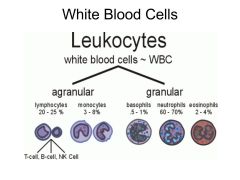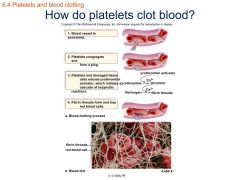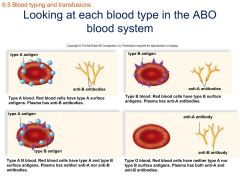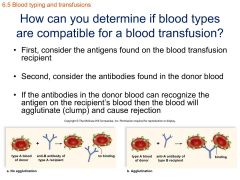![]()
![]()
![]()
Use LEFT and RIGHT arrow keys to navigate between flashcards;
Use UP and DOWN arrow keys to flip the card;
H to show hint;
A reads text to speech;
26 Cards in this Set
- Front
- Back
|
functions of blood |
Transportation: oxygen, nutrients, wastes, carbon dioxide and hormones
Defense: against invasion by pathogens
Regulatory functions: body temperature, water-salt balance and body pH |
|
|
composition of blood |
Remember: blood is a fluid connective tissue Formed elements: produced in red bone marrow Red blood cells/erythrocytes (RBC) White blood cells/leukocytes (WBC) Platelets
Plasma: 91% water and 9% salts (ions) and organic molecules Plasma proteins are the most abundant molecules |
|
|
3 major types of plasma proteins |
Albumins – most abundant and important for plasma’s osmotic pressure as well as transportation
Globulins – also important in transportation
Fibrinogen – important for the formation of blood clots |
|
|
structure of red blood cells |
Lack a nucleus and few organelles
Biconcave shape increases surface area
Contain hemoglobin molecules that bind 3 molecules of O2 each |
|
|
How is carbon dioxide transported? |
68% as a bicarbonate ion in the plasma (this conversion takes place in RBC’s)
25% in red blood cells
7% as carbon dioxide in the plasma |
|
|
Production of red blood cells |
Produced in the red bone marrow
Lifespan of about 120 days
Erythropoietin (EPO) is excreted by kidney cells and moves to red marrow when oxygen levels are low
Old cells are destroyed by the liver and spleen |
|
|
disorders involve RBC’s |
Anemia – a condition resulting from too few RBC’s or hemoglobin that causes a run-down feeling
Sickle-cell anemia – genetic disease that causes RBC’s to be sickle shaped that tend to rupture
Hemolytic disease of the newborn – a condition with incompatible blood types that leads to rupturing of blood cells in a baby before and continuing after birth |
|
|
White blood cells |
Derived from red bone marrow Large blood cells that have a nucleus Production is regulated by colony-stimulating factor (CSF) Can be found in the blood as well as in tissues Fight infection and an important part of the immune system Some live days and others live months or years |
|
|
How are white blood cells categorized? |
Granular – contain noticeable granules, lobed nuclei Eosinophil Basophil Neutrophil
Agranular – no granules, nonlobed nuclei Lymphocyte Monocyte |
|
|
Neutrophils |
About 50-70% of all WBC’s
Contain a multi-lobed nucleus
Upon infection they move out of circulation into tissues to use phagocytosis to engulf pathogens |
|
|
Eosinophils |
Small percentage of WBC’s
Contain a bilobed nucleus
Many large granules function in parasitic infections and play a role in allergies |
|
|
Basophil |
Small percentage of WBC’s
Contain a U-shaped or lobed nucleus
Release histamine related to allergic reactions |
|
|
Lymphocyte |
About 25-35% of all WBC’s
Large nucleus that takes up most of the cytoplasm
Develop into B and T cells that are important in the immune system |
|
|
Monocyte |
Relatively uncommon WBC’s
Largest WBC with horseshoe-shaped nucleus
Take residence in tissues and develop into macrophages
Macrophages use phagocytosis to engulf pathogens |
|
|
White Blood Cells |

|
|
|
What disorders involve WBC’s? |
Severe combined immunodeficiency disease (SCID) – an inherited disease in which stem cells of WBC’s lack an enzyme that allows them to fight any infection
Leukemia – groups of cancers that affect white blood cells in which cells proliferate without control
Infectious mononucleosis – also known as the “kissing disease” occurs when the Epstein-Barr virus (EBV) infects lymphocytes resulting in fatigue, sore throat and swollen lymph nodes |
|
|
Platelets |
Made of fragments of large cells called megakaryocytes made in the red bone marrow
About 200 billion are made per day
Function in blood clotting
Blood proteins named thrombin and fibrinogen are important for blood clotting by leading to fibrin threads that catch RBC’s |
|
|
How do platelets clot blood? |

|
|
|
Terminology to help understand ABO blood typing? |
Antigen - a foreign substance, often a polysaccharide or a protein, that stimulates an immune response
Antibody – proteins made in response to an antigen in the body and bind to that antigen
Blood transfusion – transfer of blood from one individual into another individual |
|
|
What determines the A, B, AB or O blood type? |
Presence and/or absence of 2 blood antigens, A and B
Type of antibodies present
Antibodies are only present for those antigens lacking on the cells because these proteins recognize and bind the protein they are named after |
|
|
How can you remember what each blood type means? |
Blood types are named after the protein antigens that are present on the surface of their cell, except type O that entirely lacks A and B proteins
Blood types only have antibodies to antigens they do not have on the surface of their cells
For example: Type A blood Have A proteins on its surface Has B antibodies
What can you say about someone with type AB blood? |
|
|
Looking at each blood type in the ABO blood system |

|
|
|
How can you determine if blood types are compatible for a blood transfusion? |

|
|
|
Testing your understanding |
Can a person with blood type O accept blood type A without agglutination occurring? Why or why not?
Why can people with AB blood type accept more blood types than people with type O, A or B?
Which blood type is able to be used most often as a donor blood type? Why? |
|
|
What about Rh blood groups? |
The Rh factor is often included when expressing a blood type by naming it positive or negative
People with the Rh factor are positive and those without it are negative
Rh antibodies only develop in a person when they are exposed to the Rh factor from another’s blood (usually a fetus) |
|
|
When is the Rh factor important? |
During pregnancy under these conditions: Mom: Rh- Dad: Rh+ Fetus: Rh+ (possible with the parents above) In this case above some Rh+ blood can leak from the fetus to the mother during birth causing the mother to make Rh antibodies This can be a problem if the mother has a second fetus that is Rh+ because she now has antibodies that can leak across the placenta and attack the fetus This condition is known as hemolytic disease of the newborn that can lead to retardation and even death |

